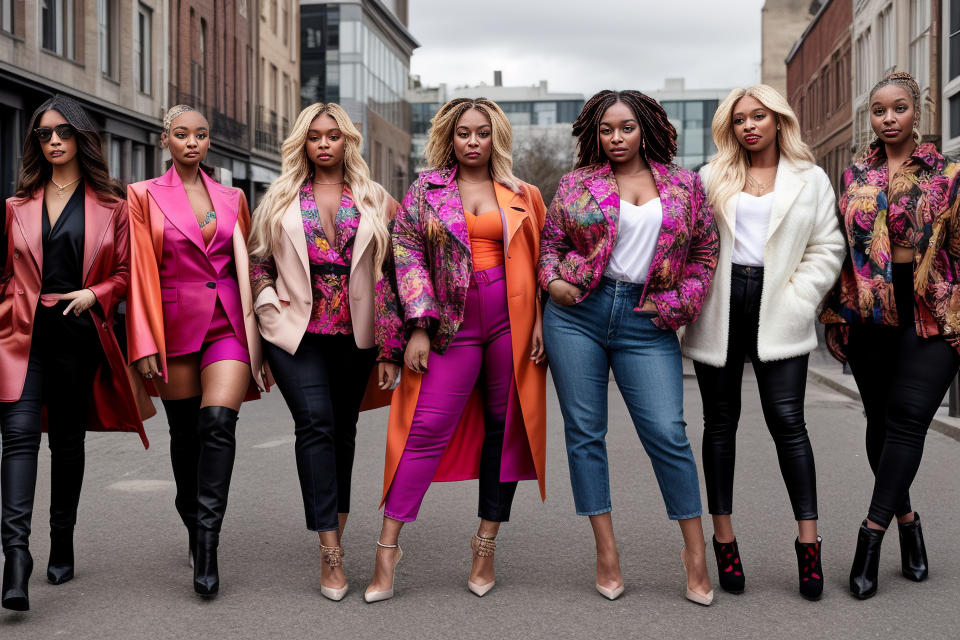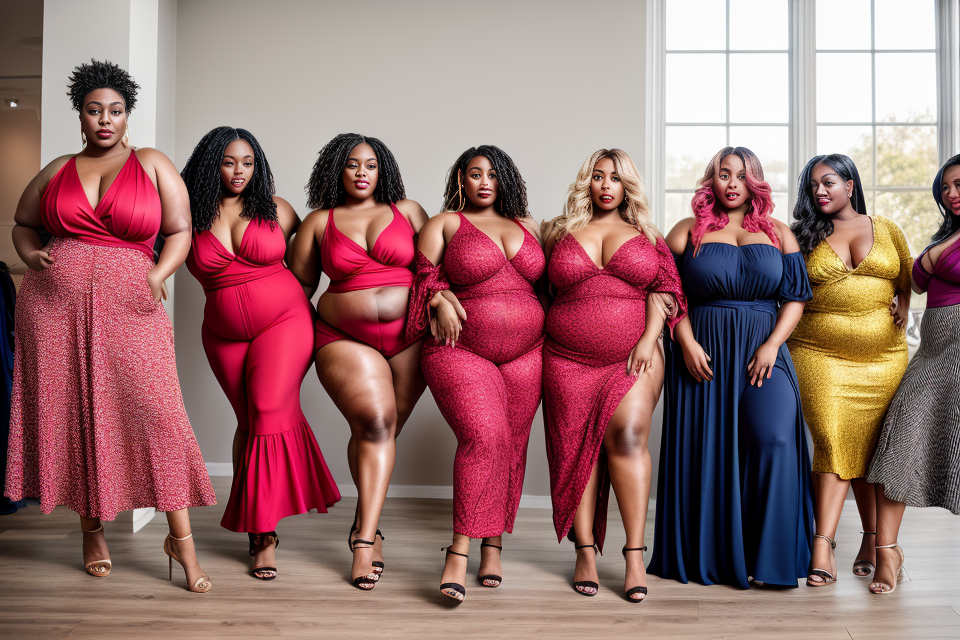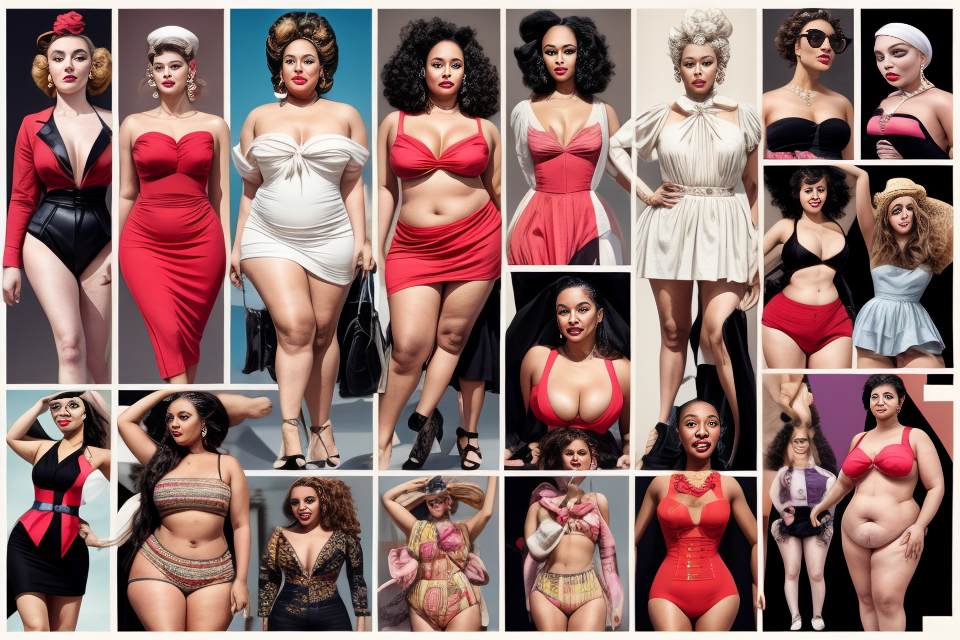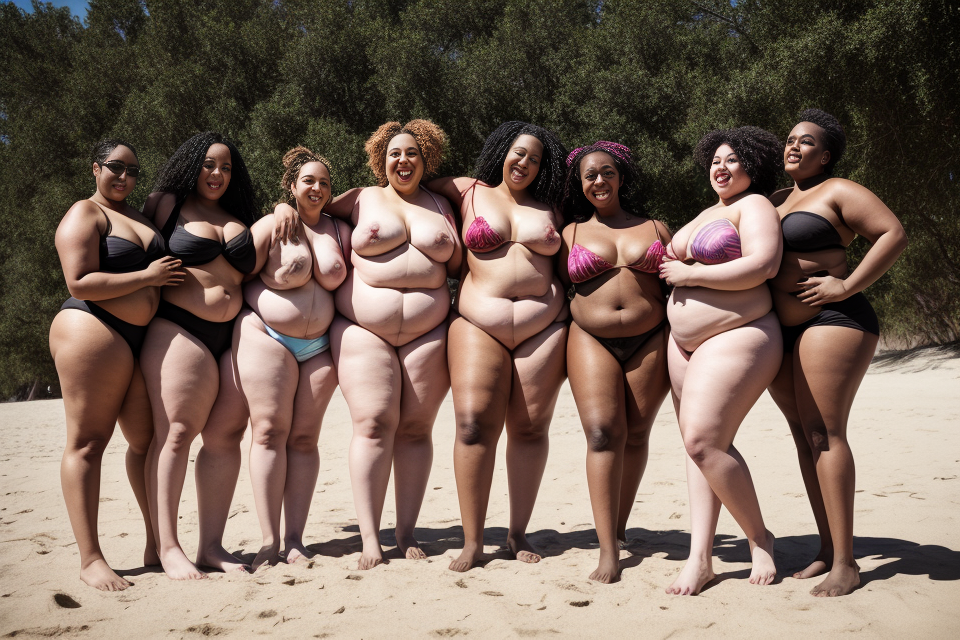Fashion and beauty have always been intertwined, with one influencing the other in a continuous cycle. However, the question remains, how does fashion impact beauty standards? The fashion industry has long been criticized for promoting unrealistic beauty standards, which can negatively affect how people view themselves. In this article, we will explore the relationship between fashion and beauty standards, and how the fashion industry can impact the way we view ourselves and our bodies. From the use of unrealistic models to the promotion of certain beauty trends, we will examine the ways in which fashion can shape our perceptions of beauty. So, let’s dive in and explore the impact of fashion on beauty standards.
Fashion has a significant impact on beauty standards as it sets trends and dictates what is considered fashionable or unfashionable. Fashion influencers and celebrities often have a significant impact on beauty standards as they are often seen as role models and their personal style can influence the trends that are popular. Additionally, fashion can also impact beauty standards by promoting certain body types or features as desirable, which can lead to unrealistic beauty standards and negative body image issues. On the other hand, fashion can also be used to challenge traditional beauty standards and promote body positivity and inclusivity. Overall, fashion can both reinforce and challenge beauty standards, and it is important to be aware of its impact and strive for a more diverse and inclusive representation of beauty.
The Role of Fashion in Society
The Power of Media
Fashion plays a significant role in shaping society’s perception of beauty. One of the primary ways it does this is through the power of media.
Influence of fashion magazines and advertisements
Fashion magazines and advertisements have a considerable impact on society’s beauty standards. They often portray a specific image of what is considered beautiful, which can influence people’s thoughts and behaviors. For example, models with specific body types and features are often featured in advertisements, which can create an unrealistic standard for beauty.
Portrayal of unrealistic beauty standards
One of the most significant impacts of fashion media is the portrayal of unrealistic beauty standards. These standards often depict models with extremely thin bodies, flawless skin, and perfect features. This can lead to body dissatisfaction and low self-esteem among individuals who do not fit these standards.
Additionally, the use of photo editing software can further exacerbate the issue. Images of models can be altered to make them appear even thinner or more perfect, which can create an even more unrealistic standard for beauty.
Furthermore, fashion magazines and advertisements often promote a specific style or trend, which can also impact society’s perception of beauty. For example, a particular hair color or style may be promoted as the “in” thing, which can lead people to feel pressure to conform to this trend.
Overall, the power of media in fashion plays a significant role in shaping society’s beauty standards. While fashion can be a form of self-expression and creativity, it is essential to be aware of the potential negative impacts it can have on body image and self-esteem.
Fashion as a Form of Self-Expression
Fashion serves as a medium for individuals to express their unique personalities and enhance their self-image. Personal style has become an essential aspect of self-expression, allowing individuals to convey their preferences, values, and attitudes through the clothes they wear. The way one dresses can provide insight into their personality, social status, and even their mood.
One significant factor contributing to the impact of fashion on self-expression is the influence of social media. Platforms like Instagram and TikTok have provided a global stage for individuals to showcase their personal style, creating a community where fashion trends and ideas are shared and discussed. The rise of influencers and fashion bloggers has further amplified the role of fashion in self-expression, as people look to these figures for inspiration and guidance on how to present themselves.
Moreover, the fashion industry has become increasingly inclusive, catering to diverse body types, ages, and cultural backgrounds. This development has enabled individuals to express their uniqueness through fashion, regardless of societal beauty standards. As a result, fashion has become a powerful tool for self-empowerment, allowing people to embrace their individuality and celebrate their uniqueness.
The impact of celebrity endorsements on fashion and self-expression cannot be overstated. Celebrities have become fashion icons, with their style choices influencing the trends and preferences of their followers. This phenomenon has led to the creation of various fashion subcultures, with people emulating the styles of their favorite celebrities or combining different elements to create a unique look.
In conclusion, fashion serves as a vital form of self-expression, enabling individuals to convey their personalities, values, and attitudes through their clothing choices. The influence of social media, the rise of influencers, and the increasing inclusivity of the fashion industry have contributed to the empowerment of individuals to express their uniqueness and challenge traditional beauty standards.
The Evolution of Beauty Standards
Historical Context
- Ancient civilizations: Early beauty standards were influenced by religious and mythological beliefs. For example, in ancient Egypt, women wore heavy makeup and adorned their hair with elaborate headdresses to emulate the goddess Isis.
- Classical period: During the Classical period, beauty standards were characterized by the ideal of physical perfection, as seen in Greek and Roman art. Women during this time were expected to have small waists, full hips, and round breasts.
- Medieval period: In the Middle Ages, beauty standards shifted towards a more demure and modest appearance. Women’s clothing became more covered, and the ideal beauty was a fair complexion and long, flowing hair.
- Renaissance: The Renaissance brought a renewed focus on the human form, with artists such as Leonardo da Vinci creating works that celebrated the beauty of the female body. This period also saw the rise of cosmetics and beauty treatments.
- Victorian era: During the Victorian era, beauty standards became more restrictive, with women expected to have small, hourglass figures and long hair that was often pulled back into a bun. Corsets were worn to achieve the desired silhouette, and makeup was considered scandalous.
- 20th century: The 20th century saw a significant shift in beauty standards, with the rise of Hollywood stars and fashion models as icons of beauty. The fashion industry played a major role in promoting certain beauty ideals, such as the hourglass figure in the 1920s, the boyish figure in the 1930s, and the curvy figure in the 1940s.
- Globalization: With the rise of globalization, beauty standards have become more diverse and international. However, they still tend to be influenced by Western ideals, with many cultures adopting similar beauty standards to those promoted by the fashion industry.
These historical contexts have contributed to the evolution of beauty standards over time, with each period leaving its mark on how society views and represents beauty.
Modern Trends
The rise of social media and influencers
The advent of social media has significantly impacted the fashion industry and beauty standards. Influencers, in particular, have played a significant role in shaping these standards. With millions of followers, influencers have the power to dictate trends and popularize certain styles. For instance, a popular influencer might post a picture wearing a particular outfit, and within days, that outfit becomes a must-have for many.
Influencers have also played a role in promoting unrealistic beauty standards. They often have perfect skin, flawless figures, and a seemingly effortless style. This has led to a rise in filters and editing tools that people use to alter their images on social media, creating an even more unattainable standard of beauty.
The impact of fast fashion and mass-produced clothing
Fast fashion has also contributed to the changing beauty standards. Fast fashion refers to the trend of producing cheap, mass-produced clothing that mimics high-fashion designs. This has made fashion more accessible to the general public, as clothing is now more affordable and readily available.
However, fast fashion has also led to a culture of disposability. With the constant release of new styles and trends, people are encouraged to buy more clothes, leading to a significant impact on the environment. Additionally, the low quality of fast fashion clothing means that it often doesn’t last long, leading to more waste.
Overall, the rise of social media and influencers, as well as the impact of fast fashion, have had a significant impact on beauty standards. These trends have made fashion more accessible, but they have also contributed to unrealistic beauty standards and a culture of disposability.
The Connection Between Fashion and Beauty Standards
Body Type Representation
- The impact of limited body types in fashion
Fashion has a significant influence on how people perceive and understand beauty standards. The representation of body types in fashion plays a crucial role in shaping these standards. In recent years, the fashion industry has faced criticism for its limited representation of body types, particularly in advertising and runway shows. This lack of diversity contributes to the perpetuation of a narrow and unrealistic beauty ideal, which can have negative consequences for individuals who do not fit into these norms.
- The normalization of unhealthy beauty standards
The fashion industry’s emphasis on a specific body type can also contribute to the normalization of unhealthy beauty standards. For example, the promotion of anorexic models and the glorification of extremely thin bodies can send harmful messages to young people and contribute to the development of eating disorders. Additionally, the use of photoshop and other digital manipulation techniques to alter images of models can further distort reality and create unrealistic expectations for individuals.
In conclusion, the fashion industry’s limited representation of body types and its promotion of unhealthy beauty standards can have a significant impact on societal perceptions of beauty. It is important for the industry to recognize its influence and take steps towards promoting more diverse and realistic representations of beauty.
Beauty as a Commodity
Fashion plays a significant role in promoting beauty products and has been instrumental in creating a multi-billion dollar beauty industry. This industry thrives on the insecurity of individuals, who are often led to believe that they are not good enough or attractive enough as they are.
- The role of fashion in promoting beauty products
Fashion magazines, advertisements, and runway shows are all tools used by the fashion industry to promote beauty products. These products range from cosmetics, skincare, and hair care to plastic surgery and other invasive procedures. The use of these products is often marketed as a way to enhance one’s appearance and achieve a certain level of beauty.
- The creation of a beauty industry based on insecurity
The beauty industry preys on people’s insecurities by promoting the idea that there is a certain standard of beauty that must be achieved in order to be accepted by society. This standard is often unattainable, and as a result, people feel compelled to purchase products and undergo procedures in an attempt to reach this ideal.
This constant pressure to conform to societal beauty standards has led to a culture of self-objectification, where individuals are more concerned with their physical appearance than their inner qualities. The beauty industry has also contributed to the normalization of unrealistic beauty standards, which can have negative effects on mental health and self-esteem.
In conclusion, the fashion industry plays a significant role in promoting beauty products and has created a multi-billion dollar beauty industry based on people’s insecurities. The constant pressure to conform to societal beauty standards can have negative effects on mental health and self-esteem.
The Critique of Fashion and Beauty Standards
The Body Positivity Movement
The push for greater diversity and inclusivity
The body positivity movement is a cultural shift that challenges traditional beauty standards and encourages individuals to embrace their bodies as they are. This movement seeks to promote acceptance and appreciation of all body types, regardless of size, shape, or appearance. The fashion industry has played a significant role in driving this movement, with designers and brands incorporating diverse models and showcasing different body types in their campaigns and runway shows.
One of the key objectives of the body positivity movement is to promote greater diversity and inclusivity in the fashion industry. This includes celebrating and showcasing a wider range of body types, as well as using more inclusive sizing and representation in marketing and advertising. Many fashion brands have responded to this call, creating clothing lines that cater to a wider range of sizes and body types, and featuring models of diverse backgrounds and appearances in their campaigns.
The rejection of unrealistic beauty standards
Another important aspect of the body positivity movement is the rejection of unrealistic beauty standards that have been perpetuated by the fashion industry and media. These standards often promote a narrow and unattainable definition of beauty, which can lead to feelings of inadequacy and low self-esteem among individuals who do not fit into these narrow definitions.
The body positivity movement challenges these standards by promoting self-acceptance and body positivity. This includes encouraging individuals to embrace their unique features and to reject the idea that they must conform to a specific standard of beauty. The movement also seeks to promote a more holistic definition of beauty, which takes into account a person’s character, personality, and inner qualities, rather than just their physical appearance.
In conclusion, the body positivity movement has had a significant impact on the fashion industry, challenging traditional beauty standards and promoting greater diversity and inclusivity. By rejecting unrealistic beauty standards and promoting self-acceptance and body positivity, this movement has helped to create a more inclusive and accepting culture, where individuals of all body types and backgrounds can feel empowered and celebrated.
The Importance of Self-Love
In a world where fashion and beauty standards are constantly being perpetuated through media and advertising, it is easy for individuals to feel pressure to conform to a certain ideal. However, the importance of self-love cannot be overstated in the context of beauty standards.
The Impact of Internalized Beauty Standards
Internalized beauty standards can have a significant impact on an individual’s self-esteem and overall mental health. When individuals feel pressure to conform to a certain ideal, they may compare themselves to others and feel inadequate when they do not meet these standards. This can lead to negative body image and a distorted sense of self-worth.
The Importance of Self-Acceptance and Self-Love
In order to combat the negative effects of internalized beauty standards, it is important for individuals to practice self-acceptance and self-love. This means accepting oneself for who they are, regardless of whether they meet societal beauty standards or not. It also means cultivating a positive self-image and learning to appreciate one’s unique qualities and strengths.
One way to cultivate self-love is to engage in activities that promote self-care, such as exercise, meditation, and self-reflection. It is also important to surround oneself with supportive individuals who encourage self-acceptance and positive self-talk.
Ultimately, self-love is essential in resisting the harmful effects of fashion and beauty standards. By prioritizing self-acceptance and self-care, individuals can cultivate a positive self-image and break free from the constraints of societal ideals.
The Future of Beauty Standards
- The potential for change and progress
- As the fashion industry continues to evolve, there is a growing awareness of the need for more inclusive and diverse beauty standards. This has led to the emergence of new trends and styles that challenge traditional beauty norms and promote a wider range of body types, skin tones, and facial features.
- In addition, there is a growing movement towards more sustainable and ethical fashion practices, which is also impacting beauty standards. Consumers are becoming more conscious of the environmental and social impact of their purchases, and this is leading to a greater emphasis on sustainable and ethical beauty products and practices.
- The importance of continued critique and discussion
- Despite these changes, it is important to continue to critique and discuss beauty standards and their impact on society. Beauty standards are deeply ingrained in our culture and can have a profound impact on how individuals feel about themselves and their bodies.
- Therefore, it is important to continue to question and challenge these standards, and to promote a more inclusive and diverse definition of beauty that reflects the diversity of our society.
- Additionally, continued discussion and critique can help to ensure that any changes in beauty standards are truly transformative and reflective of the needs and desires of all individuals, rather than just a select few.
FAQs
1. How does fashion influence beauty standards?
Fashion plays a significant role in shaping beauty standards. Designers, celebrities, and influencers often set trends and dictate what is considered attractive or fashionable. For example, certain clothing styles, hairstyles, and accessories can become popular and widely accepted as desirable, leading to an increase in their adoption by the general public. Additionally, fashion media, such as magazines and social media, often promote certain beauty ideals, which can further reinforce these standards.
2. How does beauty influence fashion?
Beauty standards can also influence fashion trends. For instance, if a certain physical feature is considered attractive, such as a particular body shape or skin tone, fashion designers may create clothing that accentuates those features. In addition, makeup and skincare trends can also be influenced by beauty standards, as people may seek to achieve a certain look or enhance their features in order to conform to these standards.
3. Are beauty standards always unrealistic and unattainable?
Yes, beauty standards can often be unrealistic and unattainable. They are often set by media and advertising, which often manipulate images to create an idealized version of beauty. This can lead to low self-esteem, body dissatisfaction, and even mental health issues for those who feel they do not measure up to these standards. However, it’s important to remember that beauty standards are subjective and can vary greatly across cultures and individuals.
4. How can we break free from the constraints of beauty standards?
Breaking free from the constraints of beauty standards requires a shift in mindset and a conscious effort to challenge societal norms. It’s important to recognize that beauty standards are not set in stone and that there is no one “ideal” look. Instead, it’s important to embrace individuality and celebrate diversity in all its forms. Encouraging self-love and self-acceptance, as well as promoting body positivity and inclusivity, can help break down the barriers created by beauty standards.



